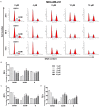Anticancer efficacies of arsenic disulfide through apoptosis induction, cell cycle arrest, and pro-survival signal inhibition in human breast cancer cells
- PMID: 29636995
- PMCID: PMC5883090
Anticancer efficacies of arsenic disulfide through apoptosis induction, cell cycle arrest, and pro-survival signal inhibition in human breast cancer cells
Abstract
Arsenic disulfide, a major effective component of realgar, has been investigated for its anti-cancer potential and shown to have therapeutic efficacies in hematological and some solid tumors. However, its effect against breast cancer is rarely reported. In this study, we investigated the anti-cancer effects of As2S2 in human breast cancer cell lines MCF-7 and MDA-MB-231, and further elucidated its underlying mechanisms. As2S2 significantly inhibited cell viabilities, induced apoptosis, and led to cell cycle arrest in both cell lines with a dose- and time-dependent manner. As2S2 upregulated pro-apoptotic proteins like p53 and PARP in MCF-7 cells. Besides, As2S2 downregulated anti-apoptotic proteins like Bcl-2 and Mcl-1, as well as cell cycle-related proteins cyclin A2 and cyclin D1 in both cell lines. Of note, the expression level of cyclin B1 was downregulated in MCF-7 cells, whereas, upregulated in MDA-MB-231 cells. Moreover, As2S2 significantly inhibited the pro-survival signals in PI3K/Akt pathway in both cell lines. In conclusion, As2S2 inhibited cell viabilities, induced apoptosis and cell cycle arrest in both MCF-7 and MDA-MB-231 cell lines by regulating the expression of key proteins involved in related pathways. These results provide fundamental insights into the clinical application of As2S2 for treatment of patients with breast cancer.
Keywords: Arsenic disulfide; MCF-7; MDA-MB-231; apoptosis; cell cycle; cell viability.
Conflict of interest statement
None.
Figures













Similar articles
-
Antitumor effects of arsenic disulfide on the viability, migratory ability, apoptosis and autophagy of breast cancer cells.Oncol Rep. 2019 Jan;41(1):27-42. doi: 10.3892/or.2018.6780. Epub 2018 Oct 9. Oncol Rep. 2019. PMID: 30320388 Free PMC article.
-
Arsenic Disulfide Combined with L-Buthionine-(S, R)-Sulfoximine Induces Synergistic Antitumor Effects in Two-Dimensional and Three-Dimensional Models of MCF-7 Breast Carcinoma Cells.Am J Chin Med. 2019;47(5):1149-1170. doi: 10.1142/S0192415X19500599. Epub 2019 Jul 17. Am J Chin Med. 2019. PMID: 31311297
-
Anti-liver cancer effect and the mechanism of arsenic sulfide in vitro and in vivo.Cancer Chemother Pharmacol. 2019 Mar;83(3):519-530. doi: 10.1007/s00280-018-3755-9. Epub 2018 Dec 12. Cancer Chemother Pharmacol. 2019. PMID: 30542770
-
Arsenic disulfide‑induced apoptosis and its potential mechanism in two‑ and three‑dimensionally cultured human breast cancer MCF‑7 cells.Int J Oncol. 2018 Jun;52(6):1959-1971. doi: 10.3892/ijo.2018.4357. Epub 2018 Apr 4. Int J Oncol. 2018. PMID: 29620191
-
Arsenic disulfide-triggered apoptosis and erythroid differentiation in myelodysplastic syndrome and acute myeloid leukemia cell lines.Hematology. 2014 Sep;19(6):352-60. doi: 10.1179/1607845413Y.0000000138. Epub 2013 Nov 25. Hematology. 2014. PMID: 24192507
Cited by
-
Arsenic Bioaccessibility of Realgar Influenced by the Other Traditional Chinese Medicines in Niuhuang Jiedu Tablet and the Roles of Gut Microbiota.Evid Based Complement Alternat Med. 2019 Dec 17;2019:8496817. doi: 10.1155/2019/8496817. eCollection 2019. Evid Based Complement Alternat Med. 2019. PMID: 31929821 Free PMC article.
-
Differentiation induction of human breast cancer cells by arsenite in combination with tetrandrine.Am J Transl Res. 2019 Dec 15;11(12):7310-7323. eCollection 2019. Am J Transl Res. 2019. PMID: 31934280 Free PMC article.
-
Acid ground nano-realgar processed product inhibits breast cancer by inducing mitophagy via the p53/BNIP3/NIX pathway.J Cell Mol Med. 2023 Nov;27(22):3478-3490. doi: 10.1111/jcmm.17917. Epub 2023 Aug 23. J Cell Mol Med. 2023. PMID: 37610095 Free PMC article.
-
As2S2 Mediates the ROS/P38 MAPK Signaling Pathway to Induce Apoptosis and S-Phase Arrest in Myelodysplastic Syndrome Cells.Curr Issues Mol Biol. 2025 Apr 7;47(4):253. doi: 10.3390/cimb47040253. Curr Issues Mol Biol. 2025. PMID: 40699652 Free PMC article.
-
Heavy Metals Toxicity: Mechanism, Health Effects, and Therapeutic Interventions.MedComm (2020). 2025 Aug 19;6(9):e70241. doi: 10.1002/mco2.70241. eCollection 2025 Sep. MedComm (2020). 2025. PMID: 40843132 Free PMC article. Review.
References
-
- Kamangar F, Dores GM, Anderson WF. Patterns of cancer incidence, mortality, and prevalence across five continents: defining priorities to reduce cancer disparities in different geographic regions of the world. J. Clin. Oncol. 2006;24:2137–2150. - PubMed
-
- Siegel R, Naishadham D, Jemal A. Cancer statistics, 2013. CA Cancer J Clin. 2013;63:11–30. - PubMed
-
- Liedtke C, Mazouni C, Hess KR, André F, Tordai A, Mejia JA, Symmans WF, Gonzalez-Angulo AM, Hennessy B, Green M, Cristofanilli M, Hortobagyi GN, Pusztai L. Response to neoadjuvant therapy and long-term survival in patients with triple-negative breast cancer. J. Clin. Oncol. 2008;26:1275–1281. - PubMed
-
- Huober J, von Minckwitz G, Denkert C, Tesch H, Weiss E, Zahm DM, Belau A, Khandan F, Hauschild M, Thomssen C, Högel B, Darb-Esfahani S, Mehta K, Loibl S. Effect of neoadjuvant anthracycline-taxane-based chemotherapy in different biological breast cancer phenotypes: overall results from the GeparTrio study. Breast Cancer Res Treat. 2010;124:133–140. - PubMed
LinkOut - more resources
Full Text Sources
Research Materials
Miscellaneous
